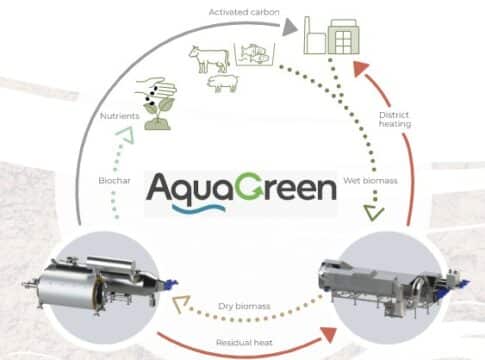US Steelmaker Applies Surcharges for Lower Carbon Emissions, Eyes Hydrogen for More Reductions
Cleveland-Cliffs, a major U.S. iron and steel maker, is putting extra charges on their steel
made from gas-fired hot-briquetted iron. The cool bit? They’re planning to use hydrogen to turn their whole operation green.
HBI is one kind of reduced iron used in making steel and producing it often involves coal used to separate oxygen from iron ore, making the industry carbon-intensive.
A Cleaner Steel Production
The steel industry is the largest emitting sector responsible for ~7% of all man-made emissions. Most crude steel production heavily relies on blast furnaces that are mostly fueled by coal.
And despite increasing focus on decarbonizing steelmaking, the global steel industry’s emissions/ton have increased steadily over the last years.
World Carbon Emissions of the Iron and Steel Industry
Source: Shao, Y. et al. (2022). Environmental Science and Pollution Research.
According to the most recent data available from the International Energy Agency (IEA), 70% of global steel production is using traditional coal-powered blast furnaces. The remaining 30% is made through electric arc furnaces (EAFs), which emit fewer CO2 than blast furnaces.
The industry’s situation in the US is quite the opposite. 70% of steel is produced using EAFs that rely on high-current electric arcs to heat metals.
The North American steel industry pledges to shrink their carbon emissions by using more EAFs and cleaning up power supply. That means replacing coal-powered furnaces with low-carbon alternatives and sourcing power from renewable sources like wind and solar.
Cleveland-Cliffs is using natural gas to make hot-briquetted iron at its Ohio site. This makes their steel production emit lower carbon emissions compared to the traditional process that uses coal and is why the American steelmaker said that its steel products deserve the surcharge.
Lourenco Goncalves, Cleveland-Cliffs CEO, said that they’ve recently applied a surcharge they call “Cliffs H” into their clients’ invoices. The additional fee charges customers with a $40/ton applied to every short ton of steel made with HBI. Commenting on the surcharge, Goncalves further noted that:
“We deserve to be paid for a characteristic of our steel that truly differentiates us, particularly when compared to other major suppliers of steel to the automotive industry in the United States.”
Passing along this cost to end consumers would be minimal, increasing the retail price of a car by ~0.1%, the CEO also said.
Away From Coal to Gas
Opting for natural gas over coal helps Cleveland-Cliffs to not only slash CO2 emissions but also cut down production costs. With the current price for natural gas, the company was able to produce HBI for less than $200/metric ton.
Still, reducing energy emissions won’t make steelmaking a low-carbon process; producers should also decrease the carbon intensity of raw materials.
Electric arc furnaces, like what Cleveland-Cliffs is using, don’t process raw iron ore. Instead, EAFs process scrap steel, pig iron, and direct reduced iron (DRI). Among these materials, pig iron made with coal emits the most CO2, while DRI made with hydrogen has the lowest emissions.
Data from S&P Global reveal the greenhouse gas emissions both from iron ore and coal production sites by region. The charts show that emissions from both productions increase from 2020 to 2021 in most regions, highest in North America.
Steel made from DRI and produced in EAFs is viewed as the most technologically mature green steel production today. Using hydrogen instead of natural gas in making DRI is the most carbon-neutral production.
And as for Cleveland-Cliffs’ CEO, the next avenue in decarbonizing steel production is through hydrogen.
But according to the IEA, there’s no significant portion of 2021 global steel production done using hydrogen-based DRI via electric arc furnaces. And that just 7% of it opted for DRI powered with either coal or natural gas.
The biggest barrier to using hydrogen in steelmaking would be the cost. Equivalent units of hydrogen are around 10x more costly than natural gas, says Goncalves. But he added that as this carbon-neutral gas becomes more economical, Cleveland-Cliffs can use it to decarbonize their operations.
Is Green Hydrogen the Future of Steel?
The full adoption of hydrogen in steelmaking depends on the economic availability of the gas itself.
Hydrogen production remains limited and demand for the most abundant gas in 2021 was at only 94 million metric tons, the IEA reported. But the energy expert estimated that demand for hydrogen will almost double to 180 million metric tons by 2030.
Recently, a Denver-based startup raised $91 million from Bill Gates and other investors to ramp up its natural hydrogen production in the Midwestern U.S.
Meanwhile, a German multinational company Thyssenkrupp AG got the European Union’s approval for a 2 billion euros, or about $2.3 billion, state subsidies for its proposed green steel production, particularly for its hydrogen-powered DRI plant at Duisburg site.
These recent developments tally with the announced clean hydrogen production capacity globally for 2030 as reported by McKinsey & Company. Companies disclosed 38 metric tons per annum in hydrogen production for the period.
Source: McKinsey & Company Hydrogen Insights
In North America alone, companies announced up to 9.3 Mt p.a. of clean hydrogen capacity by 2030, with $46 billion announced investments for 170 projects.
If these announcements and commitments materialize, green steel production with hydrogen seems to become viable for Cleveland-Cliffs and the industry.
The post US Steelmaker Applies Surcharges for Lower Carbon Emissions, Eyes Hydrogen for More Reductions appeared first on Carbon Credits.



